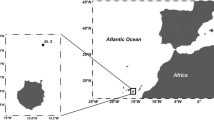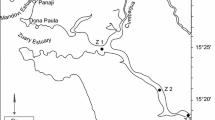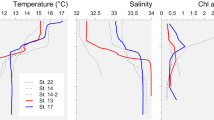Abstract
We hypothesized that the trophic level of marine copepods should depend on the composition of the protist community. To test this hypothesis, we manipulated the phytoplankton composition in mesocosms and measured grazing rates of copepods and mesozooplankton in those mesocosms. Twelve mesocosms with Northeast Atlantic phytoplankton were fertilised with different Si:N ratios from 0:1 to 1:1. After 1 week, ten of the mesocosms were filled with natural densities of mesozooplankton, mainly calanoid copepods, while two remained as mesozooplankton-free controls. Both before and after the addition of copepods there was a positive correlation of diatom dominance with Si:N ratios. During the second phase of the experiment, copepod and microzooplankton grazing rates on different phytoplankton species were assessed by a modification of the Landry-Hassett dilution technique, where the bottles containing the different dilution treatments were replaced by dialysis bags incubated in situ. The results indicated no overlap in the food spectrum of microzooplankton (mainly ciliates) and copepods. Ciliates fed on nanoplankton, while copepods fed on large or chain-forming diatoms, naked dinoflagellates, and ciliates. The calculated trophic level of copepods showed a significantly negative but weak correlation with Si:N ratios. The strength of this response was strongly dependent on the trophic levels assumed for ciliates and mixotrophic dinoflagellates.







Similar content being viewed by others
References
Calbet A, Alvarez M (1997) Growth and survival rates of early developmental stages of Acartia grani (Copepoda: Calanoida) in relation to food concentration and fluctuations in food supply. Mar Ecol Prog Ser 147:181–186
COMWEB (1999) Comparative analysis of food webs based on flow networks. Scientific report. EU-MAST III MAS3-CT96-0052
Drebes G, Schnepf E (1998) Gyrodinium undulans, Hurlburt, a marine dinoflagellate feeding on the bloom-forming diatom Odontella aurita, and on copepod and rotifer eggs. Helgol Meeresunters 52:1–14
Hillebrand H, Dürselen CD, Kischtel D, Pollingher U (1999) Biovolume calculations for pelagic and benthic microalgae. J Phycol 35:403–424
Ianora A, Poulet SA, Miralto A (1995) A comparative study of the inhibitory effect of diatoms on the reproductive biology of the copepod Temora stylifera. Mar Biol 125:279–286
Ianora A, Poulet SA, Miralto A (2003) The effects of diatoms on copepod reproduction: a review. Phycologia 42:351–363
Irigoien X, Harris RP, Verheye HM, Joly P, Runge J, Starr M, Pond D, Campbell R, Shreeve R, Ward P, Smith AN, Dam HG, Peterson W, Tirelli V, Koski M, Smith T, Habour D, Davidson R (2002) Copepod hatching success in marine ecosystems with high diatom concentrations. Nature 419:387–389
Irigoien X, Titelman J, Harris RP, Harbour D, Castellani C (2003) Feeding of Calanus finnmarchicus nauplii in the Irminger Sea. Mar Ecol Prog Ser 262:193–200
Katechakis A, Stibor H, Sommer U, Hansen T (2002) Changes in the phytoplankton community and in the microbial food web of Blanes Bay (Catalan Sea, NW-Mediterranean) under prolonged grazing pressure by doliolids (Tunicata), cladocerans or copepods (Crustacea). Mar Ecol Prog Ser 234:55–69
Kiørboe T, Saiz E, Viitasalo M (1996) Prey switching behaviour in the planktonic copepod Acartia tona. Mar Ecol Prog Ser 143:65–75
Kleppel GS (1993) On the diet of calanoid copepods. Mar Ecol Prog Ser 99:183–195
Kleppel GS, Burkart CA (1995) Egg production and the nutritional environment of Acartia tonsa: the role of food quality in copepod nutrition. ICES J Mar Sci 52:297–304
Landry MR, Hassett RR (1982) Estimating the grazing impact of marine micro-zooplankton. Mar Biol 67:283–288
Levinsen H, Turner JT, Nielsen TG, Hansen BW (2000) On the trophic coupling between protists and copepods in arctic marine ecosystems. Mar Ecol Prog Ser 204:65–77
Lund JWG, Kipling C, LeCren ED (1958) The inverted microscope method of estimating algal numbers and the statistical basis of estimations by counting. Hydrobiologia 11:143–170
Menden-Deuer S, Lessard EJ (2000) Carbon to volume relationships in dinoflagellates, diatoms and other protist plankton. Limnol Oceanogr 45:569–579
Nejstgaard JC, Gimervik I, Solberg PT (1997) Feeding and reproduction by Calanus finnmarchicus, and microzooplankton grazing during mesocosm blooms of diatoms and the coccolithophore Emiliana huxleyi. Mar Ecol Prog Ser 147:197–217
Nejstgaard JC, Hygum BH, Naustvoll LJ, Båmstedt U (2001) Zooplankton growth, diet and reproductive success compared in simultaneous diatom- and flagellate-microrozooplankton dominated plankton blooms. Mar Ecol Prog Ser 221:77–91
Rey C, Harris R, Irigoien X, Head R, Carlotti F (2001) Influence of algal diet on growth and ingestion of Calanus helgolandicus nauplii. Mar Ecol Prog Ser 216:151–165
Sommer U (1998) From algal competition to animal production: enhanced ecological efficiency of Brachionus plicatilis with a mixed diet. Limnol Oceanogr 43:1393–1396
Sommer U (1999) A comment on the proper use of nutrient ratios in microalgal ecology. Arch Hydrobiol 146:55–64
Sommer U (2002) Competition and coexistence in plankton communities. In: Sommer U, Worm B (eds) Competition and coexistence. Ecol Stud 161:79–108
Sommer U, Stibor H (2002) Copepoda–Cladocera–Tunicata: the role of three major mesozooplankton groups in pelagic food webs. Ecol Res 17:161–174
Sommer F, Stibor H, Sommer U, Velimirov B (2000) Grazing by mesozooplankton from Kiel Bight, Baltic Sea, on different sized algae and natural seston size fractions. Mar Ecol Prog Ser 199:43–53
Sommer U, Stibor H, Katechakis A, Sommer F, Hansen T (2002) Pelagic food web configurations at different levels of nutrient richness and their implications for the ratio fish production:primary production. Hydrobiologia 484:11–20
Sommer U, Sommer F, Santer B, Zöllner F, Jürgens K, Jamieson C, Boersma M, Gocke K (2003) Daphnia versus copepod impact on summer phytopankton: functional compensation on both trophic levels. Oecologia 135:639–647
Sommer U, Hansen T, Stibor H, Vadstein O (2004a) The persistence of phytoplankton responses to Si:N ration under mesozooplankton grazing: A mesocosm study with Northeast Atlantic plankton. Mar Ecol Prog Ser (in press)
Sommer U, Sommer F, Feuchtmayr H, Hansen T (2004b) The influence of mesozooplankton on phytoplankton nutrient limitation: a mesocosm study with Northeast Atlantic plankton. Protist 155:295–304
Stibor H, Vadstein O, Diehl S, Gelzleichter A, Hansen T, Katechakis A, Lippert B, Løseth K, Peters C, Roederer W, Sandow M, Sundt-Hansen L, Olsen Y (2004) Copepods act as a switch between alternative trophic cascades in marine pelagic food webs. Ecol Lett 7:321–328
Utermöhl H (1958) Zur Vervollkommnung der quantitativen Phytoplankton-Methodik. Mit Int Ver Theor Angew Limnol 9:263–272
Vadstein O, Stibor H, Lippert B, Løseth K, Roederer W, Sundt-Hansen L, Olsen Y (2004) Moderate increases in the biomass of omnivorous copepods may release grazing control of planktonic algae. Mar Ecol Prog Ser (in press)
Acknowledgements
We gratefully acknowledge financial and infrastructural support by the EU-funded research infrastructure Trondheim Marine Systems (http://www.ntnu.no/trondheim-marine-RI/) and the hospitality by Sletvik Field Station.
Author information
Authors and Affiliations
Corresponding author
Appendix
Appendix
Table 2
Rights and permissions
About this article
Cite this article
Sommer, U., Hansen, T., Blum, O. et al. Copepod and microzooplankton grazing in mesocosms fertilised with different Si:N ratios: no overlap between food spectra and Si:N influence on zooplankton trophic level. Oecologia 142, 274–283 (2005). https://doi.org/10.1007/s00442-004-1708-y
Received:
Accepted:
Published:
Issue Date:
DOI: https://doi.org/10.1007/s00442-004-1708-y




